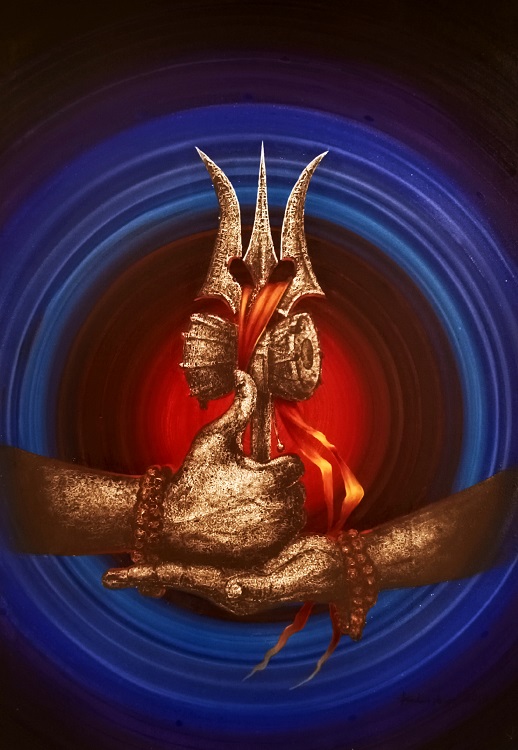
TRISHUL-Acrylic Painting on canvas 44x30 inch
ARTIST - PALASH HALDAR
TITLE - TRISHULA
Trishula (Sanskrit: त्रिशूल, IAST: triśūla) or Trishul is a trident, a divine symbol, commonly used as one of the principal symbols in Hinduism. In India and Thailand, the term also often refers to a short-handled weapon which may be mounted on a danda or staff. But unlike the Okinawan sai, the trishula is often bladed. In Malay (including Malaysian and Indonesian), trisula usually refers specifically to a long-handled trident while the diminutive version is more commonly known as a chabang or tekpi.
The trishula symbolism is polyvalent and rich. It is wielded by the god Shiva and is said to have been used to sever the original head of Ganesha. Durga also holds a trishula, as one of her many weapons. The three points have various meanings and significance, and, common to the Hindu religion, have many stories behind them. They are commonly said to represent various trinities—creation, maintenance, and destruction; past, present, and future; body, mind and atman; dharma or dhamma (law and order), bliss/mutual enjoyment and emanation/created bodies; compassion, joy and love; spiritual, psychic and relative; happiness, comfort and boredom; pride, repute and egotism; clarity, knowledge and wisdom; heaven, mind and earth; soul, fire and earth; soul, passion and embodied-soul; logic, passion and faith; prayer, manifestation and sublime; insight, serenity and Bodhisattvahood or Arhatship (anti-conceit); practice, understanding and wisdom; death, ascension and resurrection; creation, order and destruction; the three gunas. When looked upon as a weapon of Shiva, the trishula is said to destroy the three worlds: the physical world, the world of the forefathers (representing culture drawn from the past) and the world of the mind (representing the processes of sensing and acting). The three worlds are supposed to be destroyed by Shiva into a single non-dual plane of existence, that is bliss alone.
In the human body, the trishula also represents the place where the three main nadi, or energy channels (ida, pingala and sushumna) meet at the brow. Sushumna, the central one, continues upward to the 7th chakra, or energy center, while the other two ends at the brow, there the 6th chakra is located.[citation needed] The trishula's central point represents sushumna, and that is why it is longer than the other two, representing Ida and Pingala.